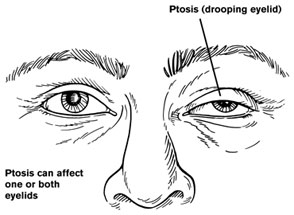Myasthenia Gravis - symptoms and treatment

Myasthenia Gravis is a rare autoimmune disorder in which the IMMUNE SYSTEM produces antibodies that target acetylcholine receptors on the cell membrane surfaces of MUSCLE cells. Acetylcholine is a NEUROTRANSMITTER that carries NERVE impulses from neurons to muscle cells to initiate movement. Acetylcholine receptors are specialized molecules that bind acetylcholine molecules, a process analogous to plugging an electrical cord into an outlet. The NEURON releases acetylcholine to carry the impulse across the synapsis to the muscle cell. Binding forms a complete circuit and the nerve impulse passes from the neuron to the muscle cell.
The antibodies present in myasthenia gravis attack and destroy acetylcholine receptors, reducing the ability of acetylcholine to carry to completion the nerve impulses that direct movement. Because there are fewer acetylcholine receptors in myasthenia gravis, the acetylcholine molecule the neuron releases often dissipates before a receptor becomes available. As a result, muscle contractions are weak. Muscles that have the fewest numbers of acetylcholine receptors to begin with-the muscles of the eyelids, eyes, face, MOUTH, and THROAT-are the most dramatically affected. Muscle function worsens during activity that uses affected muscles, such as chewing or talking, and improves after rest.
Symptoms of Myasthenia Gravis
Myasthenia gravis may develop at any age though is most common in women under age 40 and men over age 60. Researchers do not know what causes myasthenia gravis but suspect a dysfunction of the THYMUS, a structure of the immune system responsible for the maturation of T-cell lymphocytes, may play a significant role. The thymus, which normally has little function in adults, is abnormally active in people who have myasthenia gravis. Symptoms of myasthenia gravis relate to the muscles affected and may include difficulty focusing the eyes, slurred speech, or difficulty swallowing. Involvement of peripheral muscles may result in balance and gait dysfunctions.
Because myasthenia gravis is relatively rare, doctors typically explore more common causes for weak muscles before looking specifically for myasthenia gravis. BLOOD tests can detect the presence of the acetylcholine receptor antibodies in most people who have myasthenia gravis. Other diagnostic procedures that point to the disorder include specialized electromyogram (EMG) and tests that measure the muscle’s response to acetylcholine.
Myasthenia Gravis Treatment
Treatment includes anticholinesterase medications, which block the action of cholinesterase, an enzyme that breaks down acetylcholine, and IMMUNOSUPPRESSIVE MEDICATIONS, which interfere with the release of antibodies to slow the destruction of acetylcholine receptors. Many people experience significant improvement in their symptoms after THYMECTOMY (a surgical OPERATION to remove the thymus). Most people who have myasthenia gravis are able to enjoy relatively normal lives with appropriate treatment.
See also ANTIBODY; AUTOIMMUNE DISORDERS; IMMUNE RESPONSE; LYMPHOCYTE; SURGERY BENEFIT AND RISK ASSESSMENT; T-CELL LYMPHOCYTE.